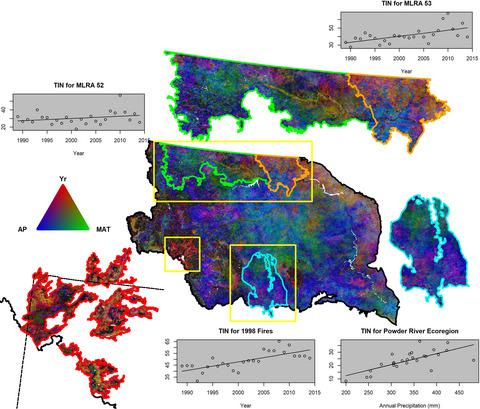当前位置:
X-MOL 学术
›
Ecol. Evol.
›
论文详情
Our official English website, www.x-mol.net, welcomes your
feedback! (Note: you will need to create a separate account there.)
Is the grass always greener? Land surface phenology reveals differences in peak and season-long vegetation productivity responses to climate and management
Ecology and Evolution ( IF 2.3 ) Pub Date : 2021-07-22 , DOI: 10.1002/ece3.7904 David J A Wood 1, 2 , Scott Powell 2 , Paul C Stoy 2, 3 , Lindsey L Thurman 1, 4 , Erik A Beever 1, 5
Ecology and Evolution ( IF 2.3 ) Pub Date : 2021-07-22 , DOI: 10.1002/ece3.7904 David J A Wood 1, 2 , Scott Powell 2 , Paul C Stoy 2, 3 , Lindsey L Thurman 1, 4 , Erik A Beever 1, 5
Affiliation

|
Vegetation phenology—the seasonal timing and duration of vegetative phases—is controlled by spatiotemporally variable contributions of climatic and environmental factors plus additional potential influence from human management. We used land surface phenology derived from the Advanced Very High Resolution Radiometer and climate data to examine variability in vegetation productivity and phenological dates from 1989 to 2014 in the U.S. Northwestern Plains, a region with notable spatial heterogeneity in climate, vegetation, and land use. We first analyzed interannual trends in six phenological measures as a baseline. We then demonstrated how including annual-resolution predictors can provide more nuanced insights into measures of phenology between plant communities and across the ecoregion. Across the study area, higher annual precipitation increased both peak and season-long productivity. In contrast, higher mean annual temperatures tended to increase peak productivity but for the majority of the study area decreased season-long productivity. Annual precipitation and temperature had strong explanatory power for productivity-related phenology measures but predicted date-based measures poorly. We found that relationships between climate and phenology varied across the region and among plant communities and that factors such as recovery from disturbance and anthropogenic management also contributed in certain regions. In sum, phenological measures did not respond ubiquitously nor covary in their responses. Nonclimatic dynamics can decouple phenology from climate; therefore, analyses including only interannual trends should not assume climate alone drives patterns. For example, models of areas exhibiting greening or browning should account for climate, anthropogenic influence, and natural disturbances. Investigating multiple aspects of phenology to describe growing-season dynamics provides a richer understanding of spatiotemporal patterns that can be used for predicting ecosystem responses to future climates and land-use change. Such understanding allows for clearer interpretation of results for conservation, wildlife, and land management.
中文翻译:

草总是更绿吗?地表物候揭示了峰值和全季植被生产力对气候和管理的响应差异
植被物候——植物生长阶段的季节时间和持续时间——受到气候和环境因素的时空变化贡献以及人类管理的额外潜在影响的控制。我们使用源自高级甚高分辨率辐射计的地表物候学和气候数据来研究美国西北平原 1989 年至 2014 年植被生产力和物候日期的变化,该地区在气候、植被和土地利用方面具有显着的空间异质性。我们首先分析了六种物候指标的年际趋势作为基线。然后,我们演示了如何将年度分辨率预测因子纳入其中,从而为植物群落和整个生态区之间的物候测量提供更细致的见解。在整个研究区域,较高的年降水量提高了峰值和整个季节的生产力。相比之下,较高的年平均气温往往会提高峰值生产力,但对于大多数研究区域来说,整个季节的生产力都会下降。年降水量和温度对与生产力相关的物候指标具有很强的解释力,但对基于日期的指标的预测效果较差。我们发现,气候和物候之间的关系在整个地区和植物群落之间存在差异,并且干扰恢复和人为管理等因素也在某些地区发挥了作用。总之,物候测量的反应并不普遍,也没有共同变化。非气候动力学可以将物候与气候脱钩;因此,仅包括年际趋势的分析不应假设气候单独驱动模式。 例如,呈现绿化或褐化的区域模型应考虑气候、人为影响和自然干扰。研究物候学的多个方面来描述生长季节动态可以更丰富地了解时空模式,可用于预测生态系统对未来气候和土地利用变化的反应。这种理解可以更清晰地解释保护、野生动物和土地管理的结果。
更新日期:2021-08-16
中文翻译:

草总是更绿吗?地表物候揭示了峰值和全季植被生产力对气候和管理的响应差异
植被物候——植物生长阶段的季节时间和持续时间——受到气候和环境因素的时空变化贡献以及人类管理的额外潜在影响的控制。我们使用源自高级甚高分辨率辐射计的地表物候学和气候数据来研究美国西北平原 1989 年至 2014 年植被生产力和物候日期的变化,该地区在气候、植被和土地利用方面具有显着的空间异质性。我们首先分析了六种物候指标的年际趋势作为基线。然后,我们演示了如何将年度分辨率预测因子纳入其中,从而为植物群落和整个生态区之间的物候测量提供更细致的见解。在整个研究区域,较高的年降水量提高了峰值和整个季节的生产力。相比之下,较高的年平均气温往往会提高峰值生产力,但对于大多数研究区域来说,整个季节的生产力都会下降。年降水量和温度对与生产力相关的物候指标具有很强的解释力,但对基于日期的指标的预测效果较差。我们发现,气候和物候之间的关系在整个地区和植物群落之间存在差异,并且干扰恢复和人为管理等因素也在某些地区发挥了作用。总之,物候测量的反应并不普遍,也没有共同变化。非气候动力学可以将物候与气候脱钩;因此,仅包括年际趋势的分析不应假设气候单独驱动模式。 例如,呈现绿化或褐化的区域模型应考虑气候、人为影响和自然干扰。研究物候学的多个方面来描述生长季节动态可以更丰富地了解时空模式,可用于预测生态系统对未来气候和土地利用变化的反应。这种理解可以更清晰地解释保护、野生动物和土地管理的结果。











































 京公网安备 11010802027423号
京公网安备 11010802027423号